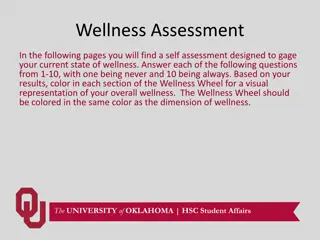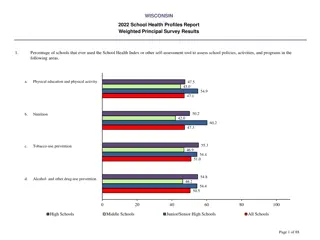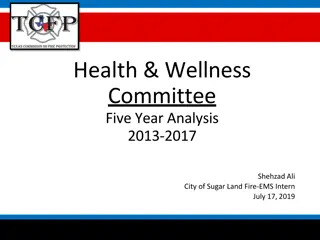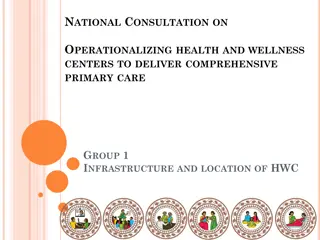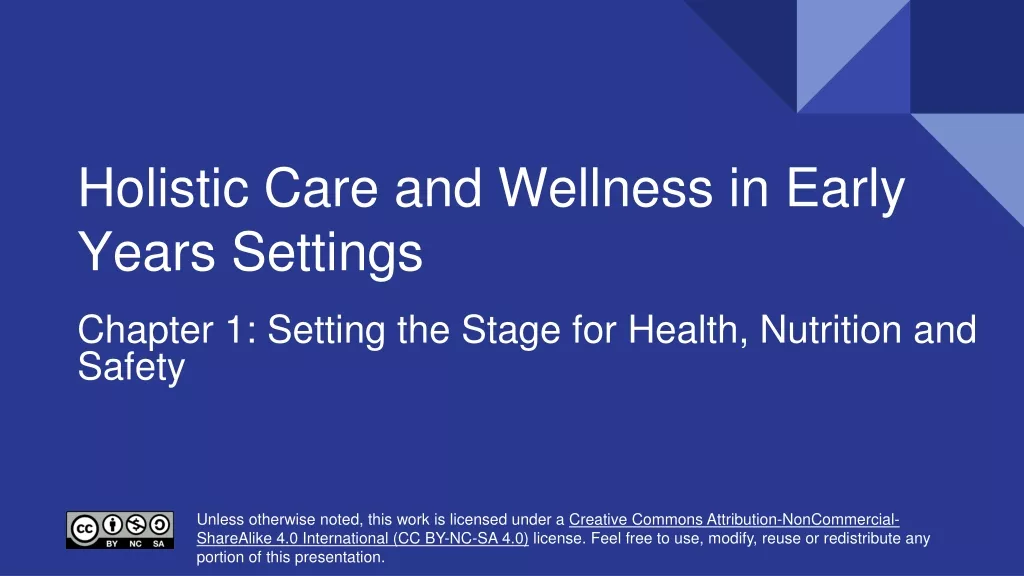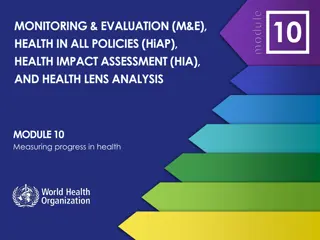Comprehensive Health Assessment and Wellness Analysis Guide
This guide provides detailed insights into assessing autonomic balance, stress levels, and cardiovascular health through various parameters like SDNN, HRV, ANS activity, and artery state. Understanding these factors can help in determining overall health status and potential risks associated with autonomic nervous system dysfunction, stress resistance, and cardiovascular disease.
Download Presentation

Please find below an Image/Link to download the presentation.
The content on the website is provided AS IS for your information and personal use only. It may not be sold, licensed, or shared on other websites without obtaining consent from the author. Download presentation by click this link. If you encounter any issues during the download, it is possible that the publisher has removed the file from their server.
E N D
Presentation Transcript
SA-3000P Result Reading Guide
1. Autonomic Balance Report TIME DOMAIN ANALYSIS SDNN: Representative parameter to indicate HRV degree. Decreased SDNN indicates ANS (Autonomic Nervous System) dysfunction. SDNN Value Status Healthy Normal Over 50 Over 30 20~30 Below 20 Attention Consulting HEART RATE VARIABILITY (HRV): Measures the degree of fluctuation in the length of intervals between heart beats. For healthy people, HRV a fluctuation in heart rates, while unhealthy people have a simple and consistent heart rate. HRV measures the adaptability of the cardiovascular system and autonomic nervous system, which is composed of the sympathetic nervous system (SNS) and parasympathetic nervous system (PNS). Your SNS plays the role of the accelerator, also known as flight or fight. Your PNS functions as the brake, also known as rest and repair. A healthy person has a balanced autonomic nervous system. FREQUENCY DOMAIN ANALYSIS: Healthy Unhealthy TP: Total Power, combination of the 3 frequencies VLF: Very Low Frequency LF: Low Frequency HF: High Frequency Reduction of TP: Decreased ANS function, decrease in regulatory competence and a decrease in the ability to cope with environmental change. Reduction of VLF: Decrease in the bodies ability to regulate body temperature and hormone levels. Reduction of LF: Loss of energy, fatigue, insufficient sleep and lethargy. Reduction of HF: Chronic stress, aging, reduced electrical stability of the heart.
2. Stress Report (DDR Report) ANS (Autonomic nervous system) ANS Activity : It s derived from TF (Total Power) on the Frequency Domain. The result is divided into 5 level and indicates the activity of ANS function and its regulation competence. ANS Balance : It s derived from LF / HF ratio on the frequency domain. If unbalanced ANS is sustained for a long time, increase the risk of cognitive or somatic pathology. ANS Stability : Indicates Autonomic Balance on the Diagram. Stress Resistance : It s derived from SDNN on Time Domain. The competence to maintain metabolic balance and stability against stressor or environmental changes. Stress Index : It s derived from PSI (physical stress index) on Time Domain. Fatigue Index : It s derived from overall tone of LF (SNS). Reduction of LF(SNS) causes the loss of energy and fatigue. Electro-Cardiac Stability : It s derived from overall tone of HF (PNS) on Frequency Domain. HF reflects the activity of parasympathetic nervous system (Vagus nerve) and it s related to electro-cardiac stability. Ectopic Beat : It means abnormal beat likes arrhythmia or artifact. If ectopic beat is more than 5, re-measurement is required
3. APG Report Level1: Blood circulation and artery state is great! Level2: Blood circulation and artery state is good but a slight build up is beginning to occur. Level3~4: Blood circulation and artery state is becoming poor and build up is starting. Level5: Blood circulation and artery state is bad and build up is increasing. Level6~7: Blood circulation and artery state is very bad and build up is becoming serious. DPI(Differential Pulse Wave Index) : Represents the overall health of the cardiovascular system. DPI is the main indicator that represents the aging of arteries. EC(Eccentric Constriction) : Represents the contraction power of vessels from the left ventricle. AE(Arterial Elasticity) : Analyzes the blood circulation, the vascular elasticity and resistance of the vessels. It detects early cardiovascular disease like atherosclerosis and peripheral circulation dysfunction. RBV(Remaining Blood Volume) : The remaining blood volume in the vessels after systolic contraction on the heart. If the blood vessels are healthy, there is little remaining blood volume. If the vascular state improves, the remaining blood volume will decrease.



